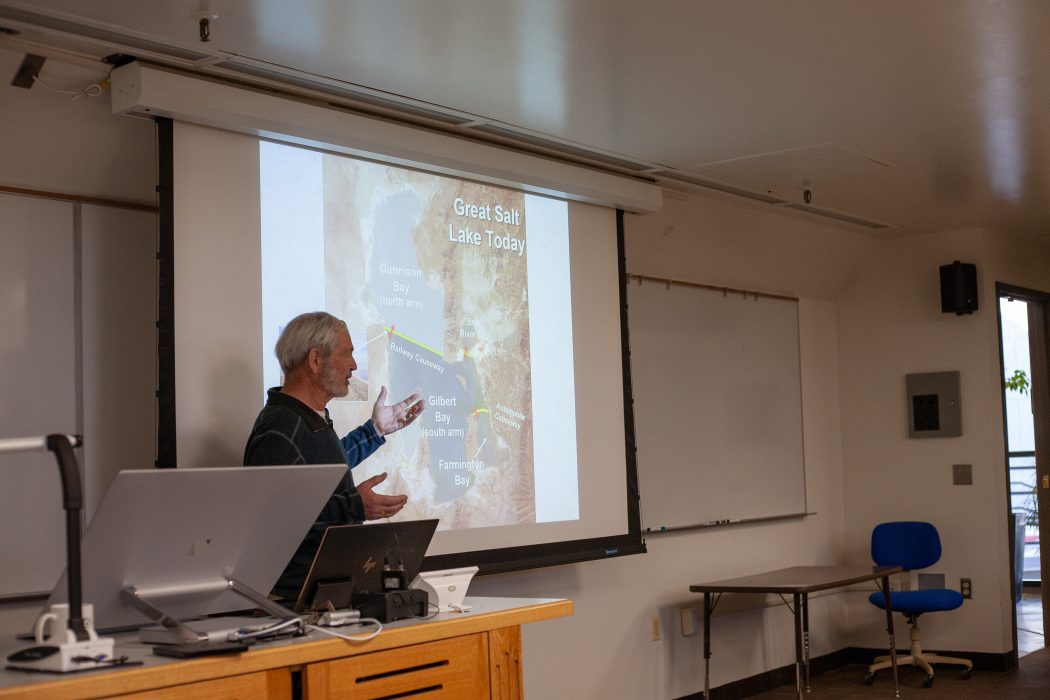USU professor discusses threats to the Great Salt Lake
The Great Salt Lake is facing multiple threats that put ecosystems, economies and species at risk, said Wayne Wurtsbaugh, Utah State University professor during a “Canyon Conversations” lecture Saturday morning.
Throughout the year, the Stokes Nature Center hosts Canyon Conversations — free, weekly seminars given by various experts about environmental topics.
Wurtsbaugh has studied marine ecosystems throughout his career and more recently has concentrated his studies on the Great Salt Lake. He focused his lecture on two main threats: the drying of the Great Salt Lake and the eutrophication of the water, or the increased amount of nutrients in the water, which causes dense plant and algae growth.
The Great Salt Lake is the largest lake west of the Mississippi River and, according to Wurtsbaugh, has an estimated economic value of over $1.3 billion. It is also the world’s largest producer of brine shrimp, which contributes over $57 million to Utah’s economy. Salt Lake is used by more than 2.5 million birds annually, too.
Wurtsbaugh explained the economic importance of the Great Salt Lake can motivate Utah State Legislature because “if they don’t care about birds and wildlife, maybe they will care about money.”
“The biggest threat to the Great Salt Lake is dewatering or drying up,” Wurtsbaugh said. “ This is a problem for terminal lakes or saline lakes worldwide.”
Three main rivers feed into the Salt Lake: the Bear, Weber and Jordan rivers. There are multiple factors that contribute to the drying of the Great Salt Lake, including droughts, decreased runoff from mountains and climate change. “What has changed the most,” Wurtsbaugh said. “Is water use, and that has caused the lake to drop about 11 feet.”
Wurtsbaugh explains this decrease has occurred over many years. “I call this decline in the Great Salt Lake ‘death by a thousand cuts’ because we did not build all the dams or pumps at the same time,” he said. “There is further planned and proposed development, especially along the Bear River.”
This drying of the Salt Lake creates dry marinas, contributes to the destruction of habitats and could potentially lead to increased dust production.
“Water use and drought have exposed almost 50% of the lake bed,” Wurtsbaugh said. “In some ways, it is much worse than that because portions of the Bear River Bay and Farmington Bay, which is the primary bird use area, have dried 70 to 80%.”
According to Wurtsbaugh, most of the water diverted from the Great Salt Lake is used for agriculture and residential use. “We are using about 39% of the river inflow, so it never makes it to the Salt Lake,” he said.
“Something we can do is use less water,” Wurtsbaugh said. “Utahns use 2.6 times more water per person than other arid countries, so we can get by with less.”
The other major threat to the Great Salt Lake is eutrophication, which is caused by increased nutrients from wastewater treatment plants along the Jordan River and Farmington Bay.
“When you flush your toilet or run your garbage disposal, all the nutrients in that waste go into the water, specifically nitrogen and phosphorous,” Wurtsbaugh said. According to Wurtsbaugh, municipalities could put in tertiary filters, but those would cost hundreds of millions of dollars.
These added nutrients promote algae and cyanobacteria growth. “Cyanobacteria, sometimes called blue-green alga, is toxic,” Wurtsbaugh said. “It can cause rashes and, while rare, people can even die from it is ingested.”
Birds and other animals ingesting the bacteria is more common. In recent years, cyanobacteria densities in Farmington Bay have reached ten times the World Health Organization’s recommendation.
Wurtsbaugh said there is good news. “Fortunately when I started out, people didn’t care too much about the Great Salt Lake … Now there is a lot of attention,” he said.
For those who want to protect the Great Salt Lake, Wurtsbaugh suggests xeriscaping or landscaping with drought-resistant plants that reduce the need for water from irrigation
He also recommends talking to government agencies such as the Cache Water District, conserving water where they can and staying involved.

